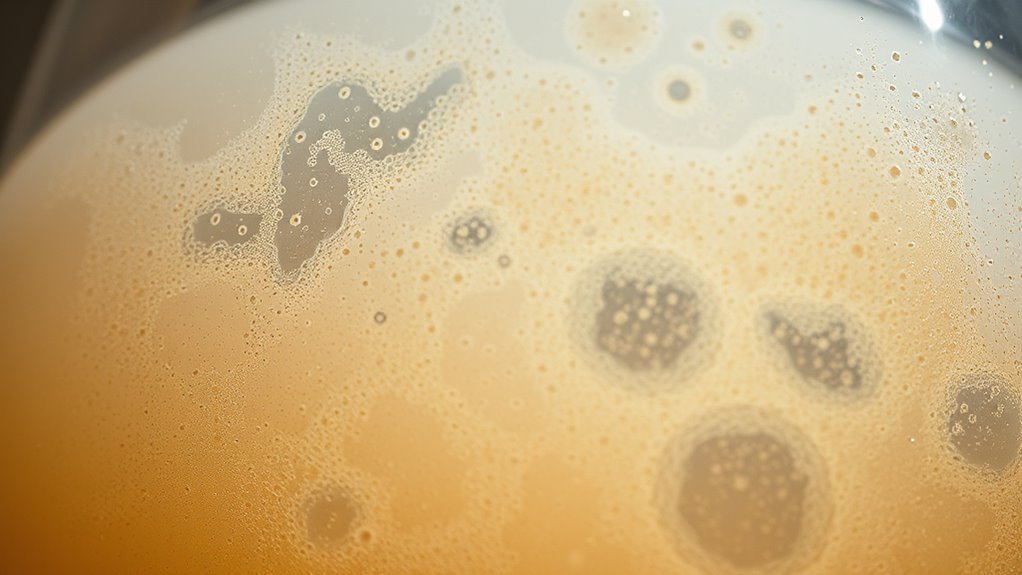Yeast-inoculated fermentation has shifted from simple techniques to advanced science, allowing you to control flavor, aroma, and consistency more precisely. Modern technologies, genetic engineering, and real-time monitoring help optimize fermentation, making it more reliable and tailored to your desired profile. While spontaneous methods offer complexity, inoculation provides predictability and efficiency. If you’re curious about how these evolving practices influence quality and innovation, there’s much more to explore beyond traditional beliefs about fermentation.
Key Takeaways
- Yeast-inoculated fermentation offers consistent, predictable results, enhancing product quality and reducing risks compared to spontaneous methods.
- Modern technology and genetic engineering enable tailored yeast strains that develop unique and complex flavors.
- Consumer demand for authenticity, transparency, and sustainability is driving interest in traditional and microbiome-based fermentation.
- Advances in automation and real-time monitoring make inoculated fermentation more efficient and controllable.
- While not a fleeting trend, yeast inoculation continues to evolve as a flavor innovation frontier in brewing and winemaking.
The Evolution of Yeast Inoculation Techniques
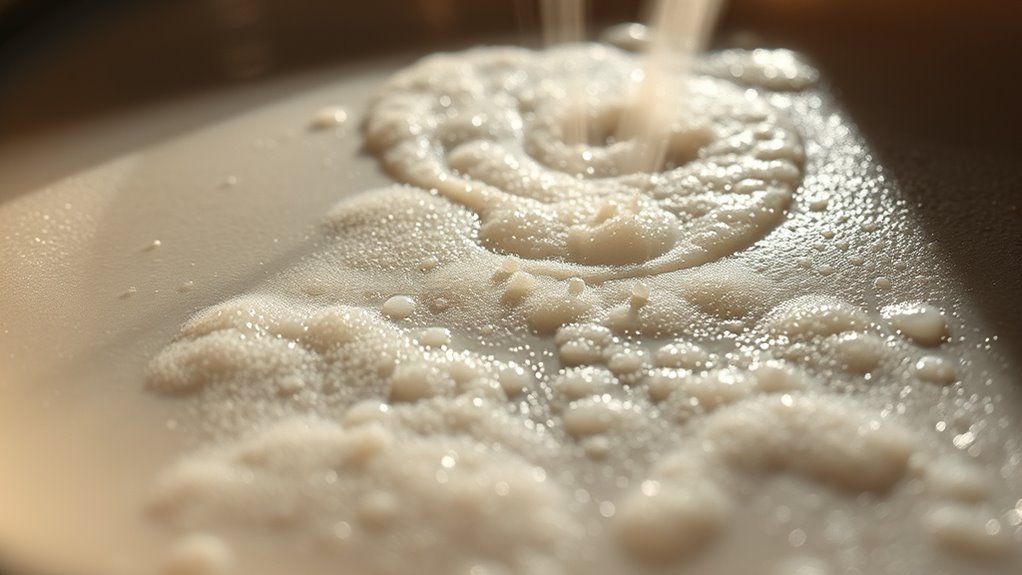
The methods used to inoculate yeast have evolved considerably over time, driven by advances in microbiology and brewing science. Today, brewers focus on fermentation sustainability by optimizing yeast propagation to reduce waste and energy use. Yeast genetic engineering plays a significant role in this evolution, allowing you to develop strains with enhanced fermentation efficiency, stress tolerance, and flavor profiles. Instead of relying solely on traditional pitching methods, you can now employ precise techniques like bioreactor cultivation and genetically tailored yeasts, improving consistency and minimizing resource consumption. These innovations help make fermentation more sustainable while giving you greater control over the fermentation process. Detect passive voice Modern inoculation methods also benefit from improved documentation and quality control, ensuring more reliable and traceable brewing practices. As a result, modern inoculation methods contribute to both environmentally friendly practices and improved brewing outcomes.
How Yeast Strains Influence Aromatic Profiles
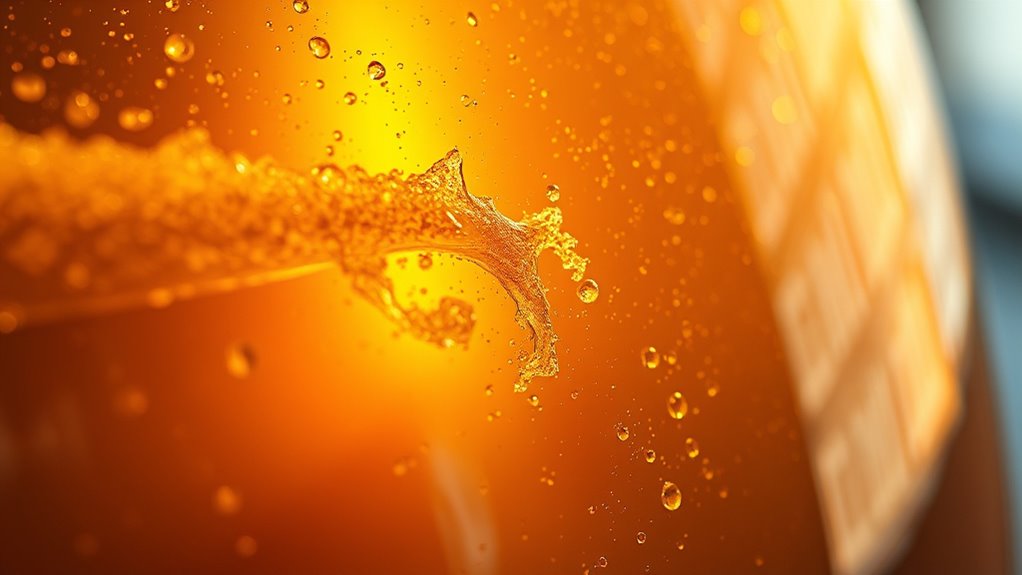
Your choice of yeast strain shapes the aromatic profile of your fermentation by producing specific strain-related aromas. Different strains generate unique fermentation byproducts that influence smell and flavor, making each batch distinct. The interactions between yeast and other ingredients further modify these aromas, emphasizing the importance of selecting the right strain for your desired outcome. Additionally, understanding Pimple Patches can be relevant in managing skin reactions to fermentation products in certain cases.
Strain-Specific Aromas
Have you ever wondered how different yeast strains can transform the aroma profile of your fermentation? Yeast strains carry unique genetic signatures that influence the production of volatile compounds, shaping distinct aromas. Through genetic modification and flavor engineering, winemakers can select strains that emphasize desired aromatic traits, such as fruity, spicy, or floral notes. These targeted approaches allow for precise control over aroma development, making each fermentation unique. Strain-specific aromas result from variations in enzyme activity and metabolic pathways, which affect ester and phenol formation. By understanding these differences, you can tailor fermentations to produce specific sensory profiles, enhancing complexity and appeal. Additionally, color accuracy impacts how these aromatic nuances are perceived visually, complementing the overall sensory experience. Ultimately, choosing the right yeast strain becomes a strategic decision, blending science and artistry to craft your desired aromatic signature.
Fermentation Byproducts Variability
Ever wondered how different yeast strains create diverse aromatic profiles during fermentation? The key lies in fermentation byproducts variability, driven by variations in yeast metabolism. These byproducts—such as esters, higher alcohols, and organic acids—shape the aroma and flavor of your wine or beer. Different yeast strains metabolize nutrients uniquely, producing distinct profiles that influence aroma complexity.
- Yeast metabolism determines the types and amounts of fermentation byproducts produced.
- Strain-specific enzymatic activities affect ester and alcohol formation.
- Environmental factors combined with yeast genetics amplify aromatic diversity.
Yeast-Flavor Interactions
Yeast strains play a crucial role in shaping the aromatic profile of fermented beverages by actively interacting with flavor precursors in the must or wort. Your choice of yeast influences the fermentation aroma, as different strains produce distinct volatile compounds that contribute to aroma complexity. Yeast diversity allows for a wide range of aromatic outcomes, from fruity and floral to spicy and earthy notes. Some strains release higher levels of esters, enhancing fruitiness, while others produce fewer byproducts, resulting in cleaner profiles. Understanding these interactions helps you tailor fermentation to achieve your desired flavor profile. By selecting specific yeast strains, you control not just fermentation speed but also the aromatic intricacies that define your beverage’s character. Yeast strain selection can also impact how well the yeast interacts with other fermentation components to produce unique aromatic nuances.
Comparing Spontaneous Versus Inoculated Fermentation

When choosing between spontaneous and inoculated fermentation, it’s important to understand how each method influences the wine’s flavor profile and fermentation process. Spontaneous fermentation relies on native yeasts, leading to longer fermentation timing and more complex flavors. Inoculated fermentation uses selected yeast strains, allowing for predictable and quicker fermentation. Additionally, enhancing life at home for the elderly can involve creating environments that support sensory engagement and well-being during wine tasting experiences.
- Fermentation timing: Spontaneous takes longer, offering depth, while inoculated is faster and more controlled.
- Inoculation methods: Using commercial yeast ensures consistency, while natural fermentation captures terroir.
- Flavor development: Spontaneous often yields unique, layered profiles; inoculated maintains desired traits.
Your choice impacts not just fermentation speed but also the wine’s ultimate character and complexity.
The Role of Technology in Modern Fermentation Practices

Advancements in technology have markedly transformed modern fermentation practices, enabling winemakers to better control and optimize the process. Biotechnological advancements, such as genome sequencing and precision fermentation tools, allow you to analyze and manipulate microbial diversity more effectively. This enhances your ability to select specific yeast strains or microbial communities that influence flavor profiles and fermentation efficiency. Automation and sensors monitor variables like temperature, pH, and sugar levels in real-time, giving you precise control over fermentation conditions. These technologies also facilitate faster troubleshooting and experimentation, reducing risks and improving outcomes. Additionally, understanding local store hours can help you plan visits for sourcing specialized products or equipment. Ultimately, integrating advanced biotech tools helps you push the boundaries of traditional fermentation, reveal new flavor dimensions and ensuring a more innovative, adaptable winemaking process.
Impact on Consistency and Quality Control

In yeast-inoculated fermentation, maintaining batch-to-batch uniformity is vital for consistent quality. You need to carefully manage contamination risks to prevent product spoilage and guarantee safety. By focusing on these areas, you can improve overall control and produce reliably high-quality results. Additionally, monitoring vetted products and formulations helps ensure safety and effectiveness throughout the process.
Batch-to-Batch Uniformity
Batch-to-batch uniformity is essential for maintaining consistent fermentation outcomes and ensuring high-quality beer production. Variations can lead to unpredictable flavors and quality issues. To achieve consistency, you need precise control over factors like fermentation timing and yeast nutrient levels. Proper timing ensures yeast activity remains steady, reducing variability. Adequate yeast nutrients promote healthy fermentation, minimizing off-flavors and stuck fermentations. Additionally, employing monitoring tools can help track fermentation progress and detect deviations early. Use standardized procedures for pitching and temperature control.
Contamination Risk Management
How significant is contamination risk in maintaining consistent fermentation and ensuring high-quality beer? It’s a critical factor that can compromise flavor, aroma, and overall product integrity. To manage this risk, implementing strict safety protocols is essential. These include sanitizing equipment thoroughly, controlling environmental conditions, and using high-quality ingredients. Regular contamination detection helps catch issues early, preventing spoilage or off-flavors from developing. Investing in proper sampling methods and microbial testing ensures your beer remains consistent across batches. By proactively addressing contamination risks, you protect your brewery’s reputation and maintain high standards. Additionally, understanding ethical hacking principles can help identify vulnerabilities in your sanitation protocols and digital systems, further safeguarding your process. Ultimately, diligent contamination risk management minimizes surprises, keeps your fermentation process reliable, and guarantees the flavor profile your customers expect.
Regional Terroirs and Traditional Fermentation Methods

Regional terroirs play a essential role in shaping the unique flavor profiles of fermented beverages, as the local climate, soil, and grape varieties influence the fermentation process. You’ll notice that yeast biodiversity varies across regions, contributing distinct characteristics to each batch. Traditional fermentation methods often rely on native yeasts, making fermentation timing critical to capturing these terroir-specific nuances. This approach allows the unique microbial community to develop naturally, enhancing complexity. Additionally, understanding yeast species diversity can help producers optimize fermentation for desired flavor outcomes.
Consumer Preferences and Market Trends
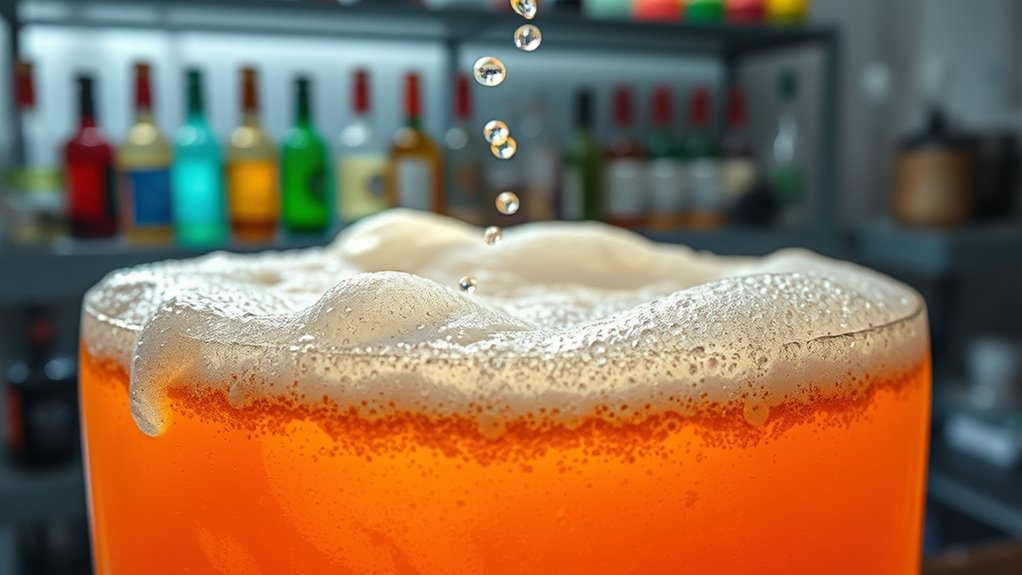
You’ll notice that more consumers are seeking organic options and prioritize products made with fewer additives. This shift favors artisanal producers who emphasize craftsmanship over mass-market production. As market trends evolve, understanding these preferences can help you better meet customer demands.
Growing Organic Preferences
Growing organic preferences are reshaping consumer choices and market dynamics in fermentation industries. More people seek products made with wild fermentation techniques, which highlight natural, microbiome-driven processes. Organic certifications have become essential, signaling authenticity and quality. Consumers increasingly prioritize transparency and sustainability, driving brands to adopt stricter standards. This shift pushes producers to focus on organic ingredients and eco-friendly practices, appealing to health-conscious buyers. Wild fermentation offers unique flavors that appeal to niche markets, while organic labels assure purity and ethical sourcing. As demand for organic options grows, businesses that embrace these trends stand to gain market share. Staying aligned with organic certifications and promoting natural fermentation processes will be key to meeting evolving consumer expectations.
Artisanal vs. Mass Market
As consumer preferences shift toward transparency and authenticity, the distinction between artisanal and mass-market fermentation products becomes increasingly clear. Artisanal producers often emphasize unique fermentation microbiomes and diverse yeast biodiversity, creating complex flavors that appeal to discerning consumers. These products showcase carefully maintained fermentation environments, highlighting local ingredients and traditional methods. In contrast, mass-market options prioritize consistency and scalability, often relying on commercial yeast strains that limit microbiome diversity. Consumers today value the story behind the product, seeking transparency about fermentation processes and microbial origins. This trend fuels demand for artisanal offerings that emphasize natural yeast biodiversity and microbial complexity, allowing them to stand out in a crowded market. Ultimately, understanding fermentation microbiomes helps consumers appreciate the nuanced flavors that differentiate artisanal from mass-market products.
Environmental and Economic Considerations
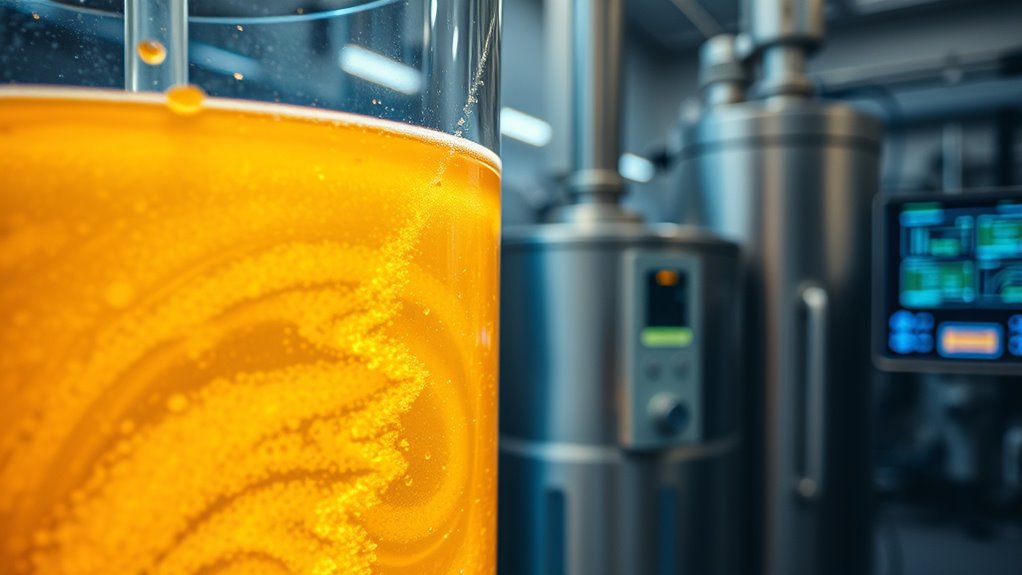
Implementing yeast-inoculated fermentation can offer notable environmental and economic benefits, but it also requires careful consideration of potential impacts. By adopting sustainable practices, you can reduce waste and energy consumption, helping the environment. Economically, this approach can lower production costs through more predictable fermentation, decreasing losses and improving yield consistency. However, you should weigh the initial setup costs and potential resource demands.
- Enhances process efficiency and reduces waste
- Promotes sustainability in production practices
- Influences economic impacts by improving profitability and reducing resource use
Case Studies: Successes and Challenges

Numerous case studies highlight both the successes and challenges associated with yeast-inoculated fermentation. For example, some wineries have used yeast genetic engineering to develop strains that enhance flavor profiles or increase fermentation efficiency. These innovations can boost product quality and consistency, but they also pose regulatory and consumer acceptance hurdles. Challenges also arise from fermentation vessel design; traditional tanks may limit oxygen transfer or temperature control, affecting yeast performance. Conversely, modern vessel designs can improve fermentation stability and scalability. Despite these advancements, some producers face setbacks due to unforeseen yeast behavior or equipment limitations. Overall, these case studies demonstrate that while yeast-inoculated fermentation offers significant potential, careful management of genetic modifications and vessel design remains essential for success.
Future Perspectives: Innovation or Overhyped Trend
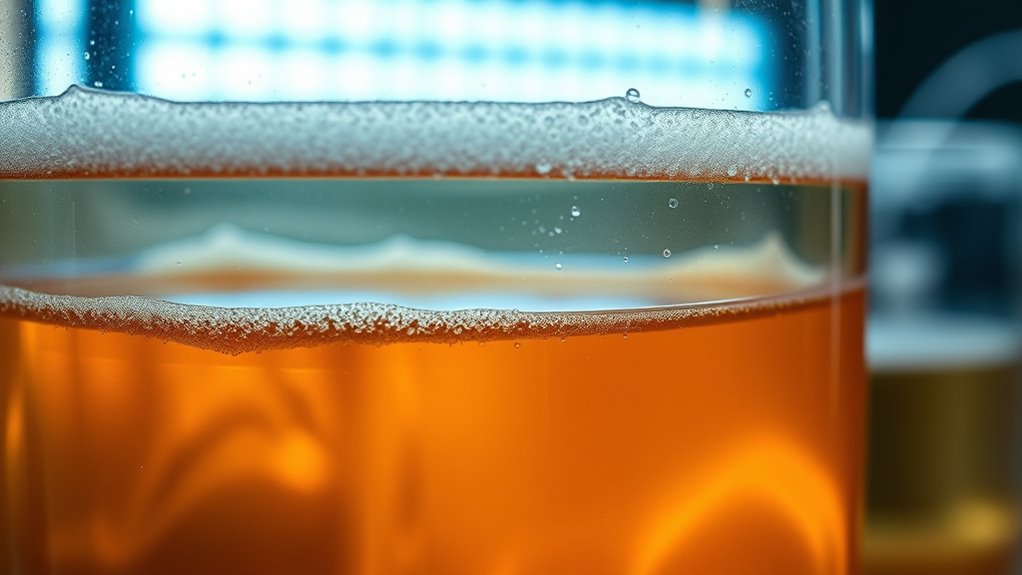
The future of yeast-inoculated fermentation is often seen as a landscape of promising innovations, but there’s also skepticism about whether these advancements are genuinely transformative or just hype. Advances like genetic engineering promise tailored flavors and improved efficiency, but they face mixed consumer perception. Some see these innovations as a breakthrough, while others worry about safety and ethics. You need to contemplate whether these developments will truly redefine fermentation or if they’re just fleeting trends.
- Genetic engineering could open new flavor profiles but may trigger consumer resistance.
- Improved fermentation techniques might boost efficiency, yet their long-term impact remains uncertain.
- Consumer perception will play a vital role in adopting these innovations, influencing market success.
Balancing innovation with transparency is key to ensuring these trends are sustainable rather than overhyped.
Frequently Asked Questions
How Does Yeast Inoculation Impact Fermentation Speed?
When you inoculate with a specific yeast strain, it directly impacts the fermentation rate, often speeding up the process. By choosing the right yeast, you control how quickly sugars convert to alcohol and flavors, making fermentation more predictable. This method allows you to optimize timing, reduce stuck fermentations, and achieve consistent results, giving you more control and efficiency in your brewing or winemaking process.
Can Inoculated Fermentation Replace Traditional Methods Entirely?
Think of inoculation techniques like tuning a musical instrument—ensuring harmony in every note. While inoculated fermentation can improve fermentation consistency and reduce unpredictability, it can’t entirely replace traditional methods. Sometimes, the artistry of spontaneous fermentation adds unique flavors that inoculation can’t replicate. So, you’ll likely see a blend of both approaches, each serving different purposes in crafting distinctive wines and beers.
What Are the Health Implications of Different Yeast Strains?
When considering different yeast strains, you should know that strain diversity impacts health benefits and potential health implications. Some strains produce beneficial compounds like antioxidants, while others might generate byproducts that could cause sensitivities or allergies. By choosing diverse strains, you can optimize flavor profiles and enhance health benefits, but it’s important to understand each strain’s effects to avoid adverse reactions and support your overall well-being.
How Does Yeast Choice Affect Wine Aging Potential?
You should consider that yeast choice impacts wine aging potential through its genetic variability and fermentation byproducts. Different yeast strains produce unique compounds that influence how well a wine ages, with some enhancing complexity and stability over time. By selecting specific yeasts, you can tailor fermentation to optimize aging, ensuring your wine develops desirable flavors and structure, making yeast a vital factor in creating wines with excellent aging potential.
Are There Legal Regulations Governing Yeast Inoculation Practices?
You should know that there are regulations governing yeast inoculation practices. Regulatory compliance is essential, as authorities often set specific rules on how and when you can inoculate yeast in winemaking. Labeling requirements also come into play, ensuring consumers are informed about the use of added yeast. By following these regulations, you can maintain legal standards and uphold transparency, safeguarding your reputation and ensuring your wine’s acceptance in the market.
Conclusion
As you explore yeast-inoculated fermentation, remember it’s like tending a garden—you choose the right strains and techniques to shape a vibrant, consistent crop. Just as a gardener’s careful planning yields a thriving vineyard, embracing technology and understanding flavor nuances can elevate your wine’s character. While some see it as a fad, the evolving landscape suggests it’s more akin to cultivating a legacy—fostering innovation that nurtures both tradition and future possibilities.
